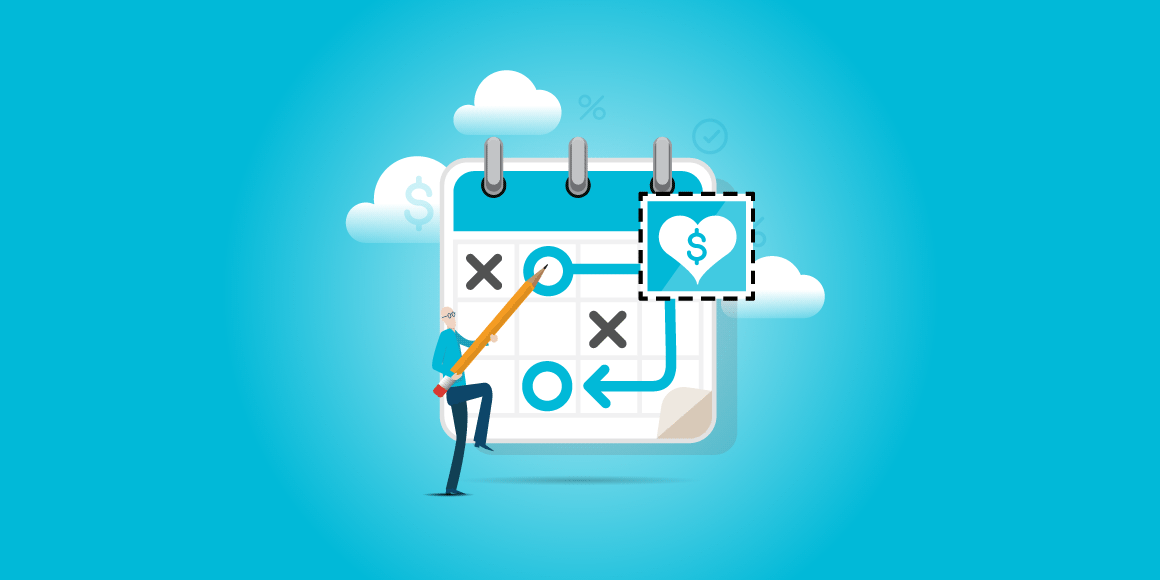A rebate program might look simple from the outside: offer a reward, collect some receipts, send the money. But behind every smooth, successful consumer rebate campaign is a strategic engine that’s been running for months.
The most impactful consumer rebate programs don’t happen by accident—they’re built through deliberate, year-round planning that connects marketing goals with operational precision, legal compliance, and real-time adjustments and optimization.
Whether you’re trying to boost sell-through in key markets, grow brand loyalty, or make your Q4 promotions unforgettable, you’ll want to construct a 12-month strategy blueprint that can transform your rebate program into a high-performing growth lever for your business.
But what does this blueprint look like? Fortunately, we’ve got you covered. See below:
January–February: Set Goals and Analyze Last Year’s Results
Step 1: Look back before you move forward.
The beginning of the year is the perfect time to pause, reflect, and reset your approach. Before you launch anything new, review the previous year’s rebate performance:
Which promotions drove the most claims?
Which saw the highest (or lowest) redemption rates and the best (or worst) ROI?
Were there patterns in customer behavior by region, product, or channel?
Step 2: Align with your internal stakeholders.
Lock in your rebate budget with finance, discuss payout thresholds and timing, and check in with your compliance team to ensure you’re aligned on regulatory requirements.
Step 3: Define measurable KPIs for the year.
Are you trying to grow market share in a specific region? Increase average order value? Reduce manual claim processing time? “You can’t improve what you don’t measure,” as the old saying goes—and that’s especially true for rebates. This is the time when you need to identify your program goals.
Key Tip: Use this period to secure executive buy-in and ensure rebates are fully integrated into your go-to-market strategy.
March–April: Design Offers and Build Your Operational Foundation
Now that you have goals in place, it’s time to translate strategy into structure.
Step 1: Map promotions to selling cycles.
At the start of this period, you’ll want to align the timing of your rebate promotions with your sales and marketing calendar. For example, are you launching new products in the spring? Planning back-to-school bundles? Consider how rebates can drive attention during those peaks.
Step 2: Determine the types of incentives you’ll offer.
Digital gift cards are fast and appealing but come with fraud risk. Prepaid cards, ACH transfers, and even physical checks each offer a different blend of convenience, security, and cost.
Step 3: This is also the ideal time to start legal and compliance reviews.
Review your terms and conditions. Address Bank Secrecy Act (BSA) and Anti-Money Laundering (AML) concerns. And if your program rewards consumers in multiple states or even multiple countries, ensure you’re handling personal data in compliance with the varying regulations frameworks like the General Data Protection Regulation (GDPR) in the EU or the California Consumer Privacy Act (CCPA).
Key Tip: If you plan your rebate promotions now, they should be ready to launch by summer. Legal and IT lead times can delay campaigns if you’re not proactive, so make sure you factor these in.
May–June: Finalize Marketing and Enrollment Infrastructure
Now that your offer mechanics and legal approvals are underway, shift focus to the customer experience. This is where your rebate program becomes real for consumers—so execution matters.
Step 1: Build branded landing pages or microsites.
Use these sites to clearly communicate offer details and provide an easy, intuitive place for claims submissions. The design should align with your branding and be optimized for mobile users.
Step 2: Thoroughly test the claims process.
Check that all form fields, logic flows, and device views function correctly, and confirm that backend systems are capturing the right data for validation, reporting, and compliance.
Step 3: Set up real-time dashboards.
This final step will allow you to easily monitor claim volume, track redemptions, and flag potential fraud early.
Key Tip: Quality Assurance (QA) every step of the user journey from a consumer’s point of view. A single glitch or confusing form field can erode trust and sink redemption rates.
July–August: Launch and Optimize Summer Promotions
Summer is where the fun begins, and you get to finally see your rebate program in action.
Step 1: Kick off your first major campaign of the year.
This is a great time to test short-term offers and evaluate how consumers engage during seasonal shifts like vacations or back-to-school.
Step 2: Closely monitor claims in real time.
Utilize your CRM to track your campaign, introduce personalized offers, and make real-time adjustments. This is an opportunity to give these high-value components a trial run before they really get put to the test.
It’s also the point when you should start watching for red flags. Early detection of duplicate receipts, suspiciously high-volume submissions, or unverifiable addresses help minimize fraud and keep your program compliant.
Step 3: Engage with customer support.
Ensure customers receive timely updates and have access to claim status tracking or help desk support. A smooth experience now builds trust for peak season.
Key Tip: Conduct a mid-year performance review in August. Use real data to refine your fall and holiday strategies while there’s still time to adjust.
September–October: Prep for Peak Season
Q4 is where rebate campaigns can make or break your year. Plan your end-of-year promotions now to avoid last-minute chaos.
Step 1: Design compelling, time-sensitive offers.
Make these offers tied to major shopping events like Black Friday, Cyber Monday, and year-end gift-giving. These promotions often generate the highest volume of claims all year.
Step 2: Coordinate closely with retail and distribution partners.
Make sure you and your partners are aligned in terms of promotional messaging, timelines, and eligibility requirements. This ecosystem orchestration creates a seamless experience across channels that builds trust and drives participation.
Step 3: Stress-test everything.
Finally, double-check that your claim submission systems, customer service capacity, and payout infrastructure are all running smoothly. Even a small technical issue can snowball when claim volume surges.
Key Tip: Plan like Q4 is a product launch. If anything can fail, it will—unless you've already prepared for scale.
November–December: Execute and Evaluate
With your holiday rebate campaigns in market, now is the time to focus on flawless execution. This is your busiest season, so every touchpoint must deliver clarity and ease-of-use.
Step 1: Communicate clearly and often.
Make sure customers understand offer eligibility, claim deadlines, and when they can expect to receive their rebate. Proactive messaging helps reduce confusion and builds trust.
Step 2: Leverage automation to send real-time claim status updates.
Keeping customers informed not only improves satisfaction but also lightens the load on your support team.
Step 3: Start your year-end reconciliation early.
Review your remaining rebate budget, flag unresolved claims, and investigate any fraud signals. Cleaning up now helps you close the year with confidence—and enter January with a clear view of what to improve.
Key Tip: Begin your year-in-review analysis before the holidays wrap. Document successes, pain points, and unexpected trends so you’re ready to plan smarter in the new year.
How Far in Advance Should You Plan Rebate Promotions?
Here’s a quick timeline to guide your planning process:
|
Task |
Ideal Lead Time |
|
Promotion concept & offer design |
3–6 months in advance |
|
Legal/compliance reviews |
6–8 weeks |
|
Tech & UX build (enrollment, claims, payout) |
2–3 months |
|
Creative & marketing approvals |
4–6 weeks |
|
In-market testing |
2–3 weeks before launch |
Pro Tip: Treat rebates like product marketing, and prepare early. If your timelines are too tight, you’ll risk both customer satisfaction and regulatory compliance.
How to Plan for the Unexpected: Appeasement Programs
Not every consumer rebate can be scheduled months in advance. Sometimes, brands need to move quickly in response to unforeseen issues, such as a product recall or a sudden service disruption. In these cases, companies often launch appeasement programs—short-term offers designed to repair trust, show goodwill, and resolve consumer frustrations.
For example, a popular appliance brand may launch a new line of washing machines, but soon after release, reports surface that some models stop mid-cycle due to a faulty sensor. Instead of forcing customers through a long warranty process, the company introduces a consumer appeasement program.
They notify registered owners, acknowledge the problem, and act quickly to make it right by offering:
- A preemptive goodwill gesture in the form of a $150 prepaid rebate card
- Free in-home service appointments to replace the defective sensor
- Clear communications that outline the issue, the fix, and the company’s appreciation for customer patience
In this case, the rebate isn’t about spurring purchases but about protecting brand trust. By providing compensation and swift solutions, the company prevents frustration from turning into negative reviews or lost loyalty, showing consumers that their satisfaction is a top priority.
These programs are reactive, so they won't always follow the same traditional planning cycle as what we’ve outlined above. Still, building flexibility into your overall strategy makes it easier to mobilize quickly when situations arise. Think of it as “planning for when you can’t truly plan.” By preparing clear workflows, approval processes, and communication channels ahead of time, brands can execute appeasement programs smoothly while protecting their reputation and customer relationships.
Conclusion: Maximize Impact with Long-Term Planning
A successful rebate program doesn’t just deliver great rewards that drive sales. When done right, it can also enhance your overall brand perception and build the lifetime value of your customers. But to get there, you need a holistic strategy that connects your campaign planning, execution, and analysis.
By using this month-by-month approach, you can:
- Keep your promotions aligned with business goals
- Ensure a frictionless customer experience
- Stay ahead of compliance and fraud risks
- Adapt to changing performance insights in real time
Need help making this the year your rebates perform at their best? Start planning now—and contact us to find out how to build a program that’s built to scale, and to last.






